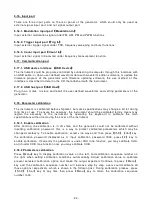
5.10.1. Repeated Period
Press
【
Menu
】
key and select “Period” option, and then set repeated period. Period represents
time from the start of one burst to the start of the next one which must be long enough to contain
the pulse numbers of setting, as the following formula shows:
Repeated period
>
(Pulse count / Pulse frequency)
If the repeated period setting is too short, the instrument will modify it to the allowable minimum
value.
5.10.2. Burst count
Press
【
Menu
】
key and select “Ncyc” option, and then set the burst count. Burst count represents
the number of cycles of burst in a repeated period, which must be small enough to be contained
in one repeated period, as following formula shows:
Pulse count
<
(repeated period ×pulse frequency)
If the burst count setting is too big, the instrument will modify it to the allowable maximum value.
5.10.3. Start phase
Press
【
Menu
】
key and select “Phase” option, and then set start and end phase value. The start
and end of the burst are always on the same phase of the waveform, this phase is named as the
start phase. The start phase setting range is 0° to 360°, it is not available to square wave.
5.10.4. Trigger source
Press
【
Menu
】
key, select “Source” option and set trigger source, there are only two values to
choose. Set the value as 0 to choose internal trigger source, and set it as 1 to choose external
trigger source. When choosing external trigger source, burst output will stop, then each time you
press
【
Shift
】【
trig
】
keys, the generator will output a burst, then keep on the start phase and
wait for next trigger. External trigger signal could be chosen as well, connect a TTL trigger signal
to the
《
Trig In
》
port on the rear panel of the generator. The generator will output a burst at the
rising edge of each trigger signal, then keep on the start phase and wait for next trigger. Of
course, the period of the trigger signal should accords with the limitation condition of repeated
period setting. W hen external trigger source is chosen, the setting of repeated period is ignored.
5.10.5. Sync output
During burst output, a sync signal can be outputted from the front panel “Sync” connector. It is a
TTL level’s pulse wave, its rising edge is corresponding to the burst starting point, while the
falling edge is corresponding to the end of the burst. That is to say, during the continuation of
burst, sync output keeps high level; during the stop period of burst, sync output keeps at low level.
In burst function, press
【
Burst
】
key again, the “Burst” keyboard indicator will be off, the
generator exits burst function and returns back to continuous function.
5.11. Arbitrary waveform
The generator could output 16 kinds of waveforms(see waveform sequence number table), where
0#
~
10# are internal fixed waveforms, which the users could only use but not edit or make any
change to, 11#
~
15# are user-defined waveforms, the users may edit arbitrary waveforms by
themselves, or edit and change current waveforms.
-19-

























